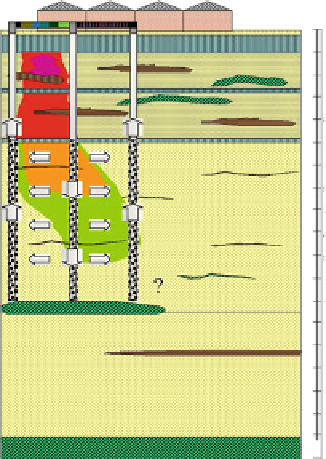Environmental Engineering Reference
In-Depth Information
Energy can be obtained from groundwater by abstracting groundwater and uti-
lizing it's thermal value (heat or cold) with a heat pump. The conventional approach
for Heat-Cold-Storage (HCS) is that groundwater is pumped from a cold zone to a
warm zone. The combination with remediation demanded a change in this approach,
because contaminants would have been moved and spread as well. Conventionally
groundwater remediation systems are designed to contain and reduce the extent of
contaminants.
Synergy of groundwater energy and remediation is possible if the necessary large
flows are used to contain the contaminants. Instead of using cold and warm zones
in the subsurface it was decided to use a so called recirculation system. This sys-
tem uses a continuous flow direction and extracts heat or cold from groundwater
with a constant temperature (see Fig.
20.15
). The remediation effect is a result of
the enhancement of naturally occurring degradation. Naturally occurring bacteria,
electron donors, nutrients and contaminants are more effectively mixed by the large
groundwater flows. The development of degradation conditions will be intensively
monitored, and adjusted if necessary with the injection of electron donor.
This combined approach leads to reductions in CO
2
emissions and use of non-
renewable energy of 30-50% compared with traditional heating. Furthermore, the
containment and remediation of the groundwater contamination does not require
additional energy, and is accomplished by the groundwater energy system. The
remediation is sustainable in a sense that it does not place any additional burden
on the environment and there is no greenhouse gas production or consumption of
non renewable sources.
m-mv
0
5
10
15
20
25
30
35
40
45
50
55
60
65
70
75
80
85
90
Fig. 20.15
“Sanergy”
schematic diagram: extraction
wells surrounding the
infiltration in the middle of
the contaminant plume

Search WWH ::

Custom Search